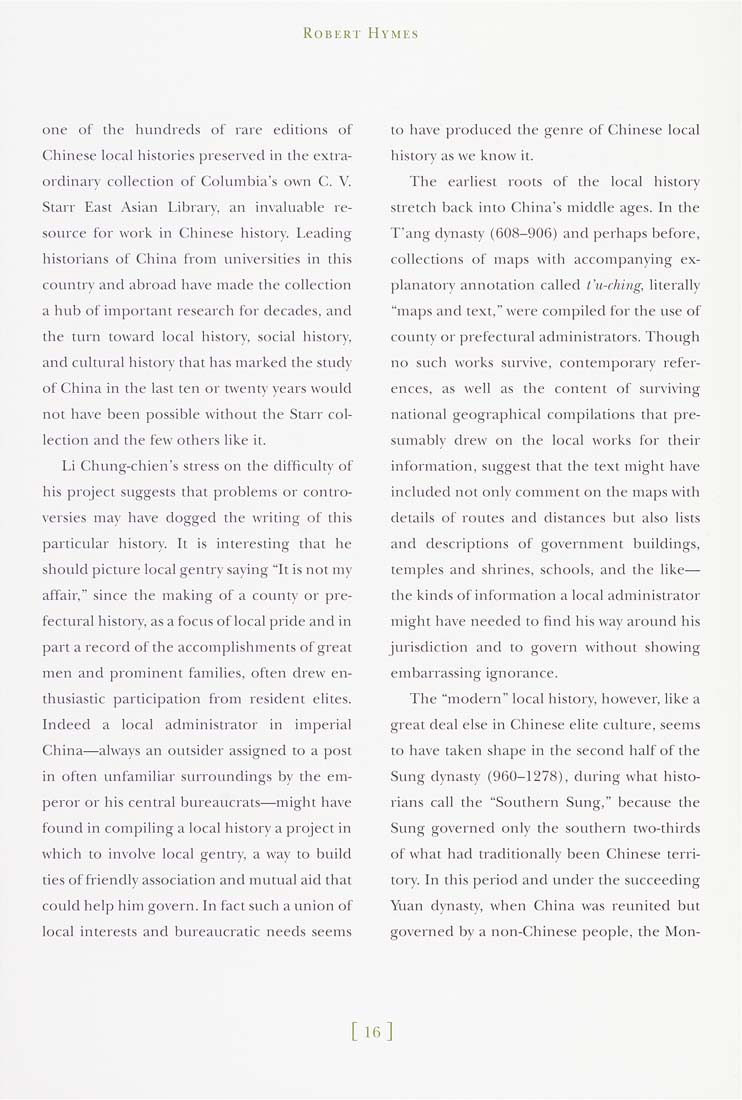Columbia Library columns (v.45(1996))
(New York : Friends of the Columbia Libraries. )
|
||
|
|
|
|
| v.45,no.1(1996:Spring): Page 16 |

Robert Hymes one of the hundreds of rare editions of (Chinese local histories preserved in the extra¬ ordinary collection of Columbia's own C. V. Starr East Asian Libraiy an invahiable re- somxe for work in Chinese history. Leading historians of China from universities in this country and abroad have made the collection a hub of important research for decades, and the turn toward local history, social history, and cultural history that has marked the study of C^hina in the last ten or twentv years \votild not have been possible without the Starr col¬ lection and the few others like it. Li Chung-chien's stress on the diffictilty of his project suggests that problems or contro¬ versies may have dogged the wTiting of this particular history. It is interesting that he should picture local gentry saving "It is not my affair," since the making of a county or pre- fectural history, as a focus of local pride and in part a record of the accomplishments of great men and prominent families, often drew en¬ thusiastic participation from resident elites. Indeed a local administrator in imperial China—alwavs an outsider assigned to a post in often unfamiliar surroundings by the em¬ peror or his central bureaucrats—might have found in compiling a local history a project in which to involve local gentry, a way to build ties of friendly association and mutual aid that could help him govern. In fact such a union of local interests and biueaucratic needs seems to have produced the genre of Chinese local history as we know it. The earliest roots of the local history stretch back into China's middle ages. In the T'ang dynasty (608-906) and perhaps before, collections of maps with accompanying ex¬ planatory annotation called t'u-ching, literally "maps and text," were compiled for the use of county or prefectural administrators. Though no such works survive, contemporary refer¬ ences, as well as the content of surviving national geographical compilations that pre¬ sumably drew on the local works for their information, suggest that the text might have included not only comment on the maps with details of routes and distances but also lists and descriptions of government btiildings, temples and shrines, schools, and the like— the kinds of information a local administrator might have needed to find his way around his jurisdicdon and to go\ern without showing embarrassing ignorance. The "modern" local history, however, like a great deal else in Chinese elite culture, seems to have taken shape in the second half of the Sung dynasty (960-1278), during what histo¬ rians call the "Southern Sung," because the Sung governed only the southern two-thirds of what had tradidonally been Chinese terri¬ tory. In this period and tmder the succeeding Yuan dynasty, when China was reunited but governed by a non-Chinese people, the Mon- [16: |
| v.45,no.1(1996:Spring): Page 16 |







